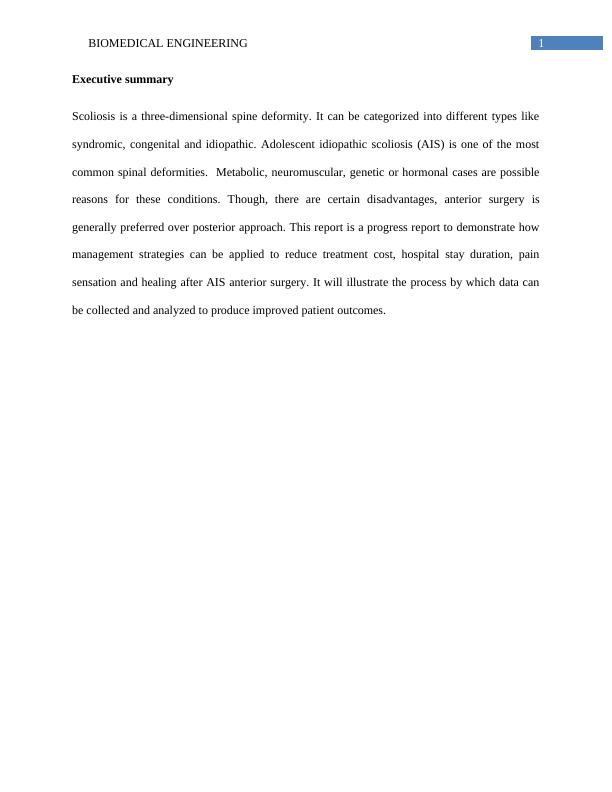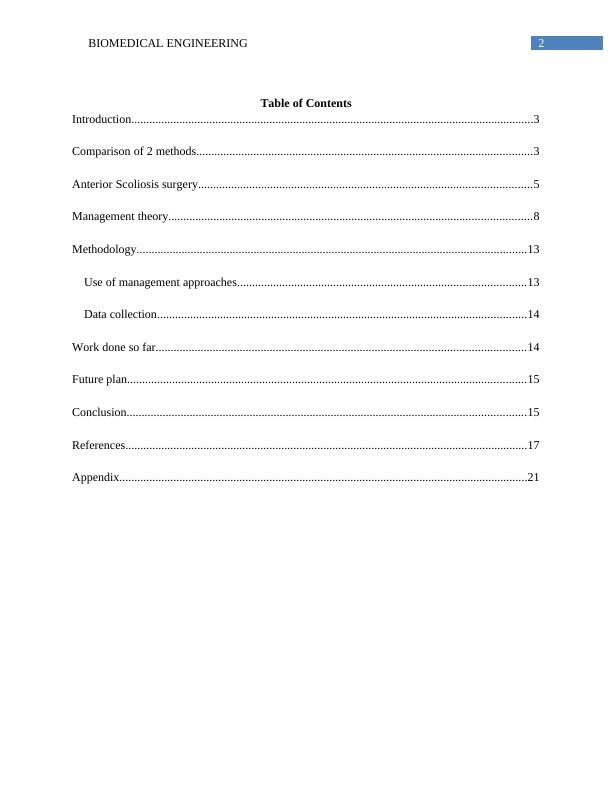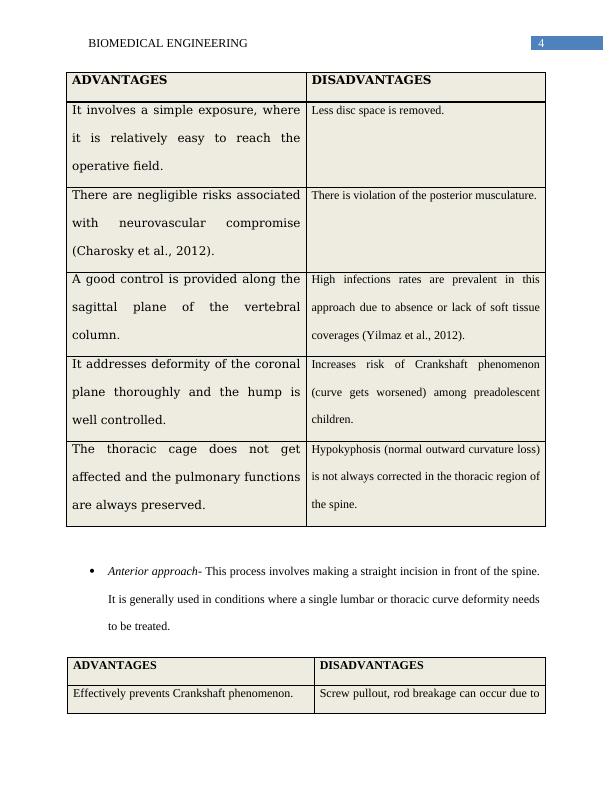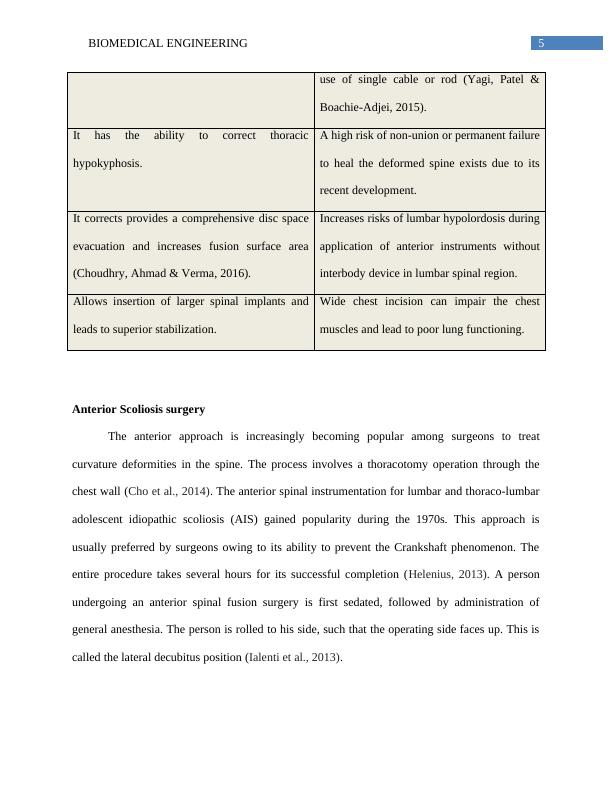Anisotropic Approach to Treatment Adolescent Idiopathic Scoliosis
Added on 2020-03-16
24 Pages4395 Words347 Views
Running head: BIOMEDICAL ENGINEERING
Progress report on anterior approach to treat Adolescent Idiopathic Scoliosis (AIS)
Name of the Student
Name of the University
Author Note
Progress report on anterior approach to treat Adolescent Idiopathic Scoliosis (AIS)
Name of the Student
Name of the University
Author Note

1BIOMEDICAL ENGINEERING
Executive summary
Scoliosis is a three-dimensional spine deformity. It can be categorized into different types like
syndromic, congenital and idiopathic. Adolescent idiopathic scoliosis (AIS) is one of the most
common spinal deformities. Metabolic, neuromuscular, genetic or hormonal cases are possible
reasons for these conditions. Though, there are certain disadvantages, anterior surgery is
generally preferred over posterior approach. This report is a progress report to demonstrate how
management strategies can be applied to reduce treatment cost, hospital stay duration, pain
sensation and healing after AIS anterior surgery. It will illustrate the process by which data can
be collected and analyzed to produce improved patient outcomes.
Executive summary
Scoliosis is a three-dimensional spine deformity. It can be categorized into different types like
syndromic, congenital and idiopathic. Adolescent idiopathic scoliosis (AIS) is one of the most
common spinal deformities. Metabolic, neuromuscular, genetic or hormonal cases are possible
reasons for these conditions. Though, there are certain disadvantages, anterior surgery is
generally preferred over posterior approach. This report is a progress report to demonstrate how
management strategies can be applied to reduce treatment cost, hospital stay duration, pain
sensation and healing after AIS anterior surgery. It will illustrate the process by which data can
be collected and analyzed to produce improved patient outcomes.

2BIOMEDICAL ENGINEERING
Table of Contents
Introduction......................................................................................................................................3
Comparison of 2 methods................................................................................................................3
Anterior Scoliosis surgery...............................................................................................................5
Management theory.........................................................................................................................8
Methodology..................................................................................................................................13
Use of management approaches................................................................................................13
Data collection...........................................................................................................................14
Work done so far...........................................................................................................................14
Future plan.....................................................................................................................................15
Conclusion.....................................................................................................................................15
References......................................................................................................................................17
Appendix........................................................................................................................................21
Table of Contents
Introduction......................................................................................................................................3
Comparison of 2 methods................................................................................................................3
Anterior Scoliosis surgery...............................................................................................................5
Management theory.........................................................................................................................8
Methodology..................................................................................................................................13
Use of management approaches................................................................................................13
Data collection...........................................................................................................................14
Work done so far...........................................................................................................................14
Future plan.....................................................................................................................................15
Conclusion.....................................................................................................................................15
References......................................................................................................................................17
Appendix........................................................................................................................................21

3BIOMEDICAL ENGINEERING
Introduction
Scoliosis deformity is defined by the Scoliosis Research Society as the lateral curvature
of the spine in the coronal plane. This deformity is detected by a radiograph of the spine, taken in
standing posture. The degree of the curve is measured as the angle between most inclined end-
plates of the vertebral column, at the end of each curve measures the degree of the curve and is
referred to as the Cobb angle (Weinstein et al., 2013). Adolescent idiopathic scoliosis (AIS)
manifests as a curvature of the lumbar and the thoracic spine. If there is a persistent lateral
curvature of more than 10 degrees between the lumbar and thoracic spine, in upright position, the
condition is termed AIS. It is a complex 3-dimensional deformity due to spine rotation and
various plane curvatures in addition to lateral curvature. Surgery is generally used to treat the
scoliotic deformity, which is likely to progress. AIS surgery is recommended for adolescents
with a spinal curve with Cobb angle values larger than 45°-50° (Konieczny, Senyurt & Krauspe,
2013). The surgical procedures aim to achieve a solid fusion, correct the deformity and improve
cosmetic appearance. Thereby, the curve progression gets arrested.. The main principle
underlying this technique is using the spine in the form of a structural scaffold to cement the
parts using a bone paste on the scaffold (Donzelli et al., 2014). Metal screws, rods and wires are
used to reinforce fusion stability. A posterior or an anterior approach can be used for this fusion
surgery.
Comparison of 2 methods
Posterior approach- The process involves a straight incision along the midline. It is most
commonly used to treat all curvature defects.
Introduction
Scoliosis deformity is defined by the Scoliosis Research Society as the lateral curvature
of the spine in the coronal plane. This deformity is detected by a radiograph of the spine, taken in
standing posture. The degree of the curve is measured as the angle between most inclined end-
plates of the vertebral column, at the end of each curve measures the degree of the curve and is
referred to as the Cobb angle (Weinstein et al., 2013). Adolescent idiopathic scoliosis (AIS)
manifests as a curvature of the lumbar and the thoracic spine. If there is a persistent lateral
curvature of more than 10 degrees between the lumbar and thoracic spine, in upright position, the
condition is termed AIS. It is a complex 3-dimensional deformity due to spine rotation and
various plane curvatures in addition to lateral curvature. Surgery is generally used to treat the
scoliotic deformity, which is likely to progress. AIS surgery is recommended for adolescents
with a spinal curve with Cobb angle values larger than 45°-50° (Konieczny, Senyurt & Krauspe,
2013). The surgical procedures aim to achieve a solid fusion, correct the deformity and improve
cosmetic appearance. Thereby, the curve progression gets arrested.. The main principle
underlying this technique is using the spine in the form of a structural scaffold to cement the
parts using a bone paste on the scaffold (Donzelli et al., 2014). Metal screws, rods and wires are
used to reinforce fusion stability. A posterior or an anterior approach can be used for this fusion
surgery.
Comparison of 2 methods
Posterior approach- The process involves a straight incision along the midline. It is most
commonly used to treat all curvature defects.

4BIOMEDICAL ENGINEERING
ADVANTAGES DISADVANTAGES
It involves a simple exposure, where
it is relatively easy to reach the
operative field.
Less disc space is removed.
There are negligible risks associated
with neurovascular compromise
(Charosky et al., 2012).
There is violation of the posterior musculature.
A good control is provided along the
sagittal plane of the vertebral
column.
High infections rates are prevalent in this
approach due to absence or lack of soft tissue
coverages (Yilmaz et al., 2012).
It addresses deformity of the coronal
plane thoroughly and the hump is
well controlled.
Increases risk of Crankshaft phenomenon
(curve gets worsened) among preadolescent
children.
The thoracic cage does not get
affected and the pulmonary functions
are always preserved.
Hypokyphosis (normal outward curvature loss)
is not always corrected in the thoracic region of
the spine.
Anterior approach- This process involves making a straight incision in front of the spine.
It is generally used in conditions where a single lumbar or thoracic curve deformity needs
to be treated.
ADVANTAGES DISADVANTAGES
Effectively prevents Crankshaft phenomenon. Screw pullout, rod breakage can occur due to
ADVANTAGES DISADVANTAGES
It involves a simple exposure, where
it is relatively easy to reach the
operative field.
Less disc space is removed.
There are negligible risks associated
with neurovascular compromise
(Charosky et al., 2012).
There is violation of the posterior musculature.
A good control is provided along the
sagittal plane of the vertebral
column.
High infections rates are prevalent in this
approach due to absence or lack of soft tissue
coverages (Yilmaz et al., 2012).
It addresses deformity of the coronal
plane thoroughly and the hump is
well controlled.
Increases risk of Crankshaft phenomenon
(curve gets worsened) among preadolescent
children.
The thoracic cage does not get
affected and the pulmonary functions
are always preserved.
Hypokyphosis (normal outward curvature loss)
is not always corrected in the thoracic region of
the spine.
Anterior approach- This process involves making a straight incision in front of the spine.
It is generally used in conditions where a single lumbar or thoracic curve deformity needs
to be treated.
ADVANTAGES DISADVANTAGES
Effectively prevents Crankshaft phenomenon. Screw pullout, rod breakage can occur due to

5BIOMEDICAL ENGINEERING
use of single cable or rod (Yagi, Patel &
Boachie-Adjei, 2015).
It has the ability to correct thoracic
hypokyphosis.
A high risk of non-union or permanent failure
to heal the deformed spine exists due to its
recent development.
It corrects provides a comprehensive disc space
evacuation and increases fusion surface area
(Choudhry, Ahmad & Verma, 2016).
Increases risks of lumbar hypolordosis during
application of anterior instruments without
interbody device in lumbar spinal region.
Allows insertion of larger spinal implants and
leads to superior stabilization.
Wide chest incision can impair the chest
muscles and lead to poor lung functioning.
Anterior Scoliosis surgery
The anterior approach is increasingly becoming popular among surgeons to treat
curvature deformities in the spine. The process involves a thoracotomy operation through the
chest wall (Cho et al., 2014). The anterior spinal instrumentation for lumbar and thoraco-lumbar
adolescent idiopathic scoliosis (AIS) gained popularity during the 1970s. This approach is
usually preferred by surgeons owing to its ability to prevent the Crankshaft phenomenon. The
entire procedure takes several hours for its successful completion (Helenius, 2013). A person
undergoing an anterior spinal fusion surgery is first sedated, followed by administration of
general anesthesia. The person is rolled to his side, such that the operating side faces up. This is
called the lateral decubitus position (Ialenti et al., 2013).
use of single cable or rod (Yagi, Patel &
Boachie-Adjei, 2015).
It has the ability to correct thoracic
hypokyphosis.
A high risk of non-union or permanent failure
to heal the deformed spine exists due to its
recent development.
It corrects provides a comprehensive disc space
evacuation and increases fusion surface area
(Choudhry, Ahmad & Verma, 2016).
Increases risks of lumbar hypolordosis during
application of anterior instruments without
interbody device in lumbar spinal region.
Allows insertion of larger spinal implants and
leads to superior stabilization.
Wide chest incision can impair the chest
muscles and lead to poor lung functioning.
Anterior Scoliosis surgery
The anterior approach is increasingly becoming popular among surgeons to treat
curvature deformities in the spine. The process involves a thoracotomy operation through the
chest wall (Cho et al., 2014). The anterior spinal instrumentation for lumbar and thoraco-lumbar
adolescent idiopathic scoliosis (AIS) gained popularity during the 1970s. This approach is
usually preferred by surgeons owing to its ability to prevent the Crankshaft phenomenon. The
entire procedure takes several hours for its successful completion (Helenius, 2013). A person
undergoing an anterior spinal fusion surgery is first sedated, followed by administration of
general anesthesia. The person is rolled to his side, such that the operating side faces up. This is
called the lateral decubitus position (Ialenti et al., 2013).

End of preview
Want to access all the pages? Upload your documents or become a member.
Related Documents
Investigation of project management aspects of anterior surgical approach in adolescence idiopathic scoliosis treatmentlg...
|57
|12942
|164
Understanding Scoliosis and its Diagnosis and Treatment Plan with Aid of MRI and CT Scanlg...
|15
|4057
|431
Project Management Aspect of Bone Substitutelg...
|13
|3456
|176
